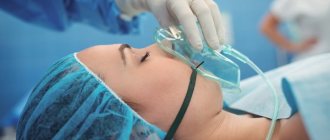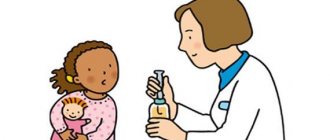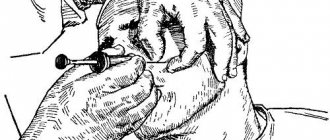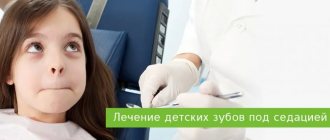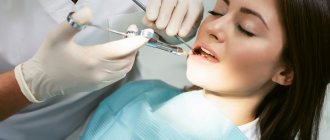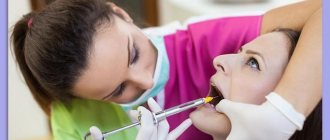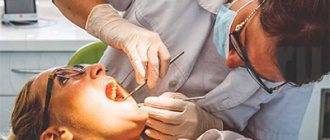Types of anesthesia in pediatric dentistry
The child’s health requires a delicate attitude, so special attention is paid to choosing the optimal method of pain relief. Three methods are used in pediatric dentistry:
- Local anesthesia
. Local anesthesia using sprays, gels and injections. - General anesthesia (anesthesia)
. Putting the patient to sleep so that the doctor can freely work in his oral cavity. - Nitrous oxide sedation
. In essence, sedation is not anesthesia. She calms the little patient, relieves stress and helps him undergo a complex operation.
At the dental clinic " Natadent"
“All of the listed methods
of anesthesia are used when treating children's teeth
. The most appropriate method is selected taking into account the expected duration and complexity of the procedure, as well as the age and personal characteristics of the child. Let's look at each approach in more detail.
Article - Pediatric dentistry
Features of anesthesia in children in dentistry
In pediatric practice, pain relief plays a primary role.
If an adult patient is able to endure mild discomfort and spend several hours in a row in a chair, then the child’s psyche is not yet ready for this. A painful procedure can instill a lifelong fear of dentists and interfere with quality treatment. Moreover, anesthesia gives the desired psychological effect and helps the child trust the doctor. Features of pain relief in children
- Most drugs can only be used from the age of four, which imposes severe restrictions on the treatment of very young patients.
- The anesthesiologist must be highly qualified and be able to correctly calculate the dosage.
- The child may be afraid of treatment and dental instruments, especially needles.
- Children are often allergic to anesthetics.
The choice of one type or another depends on the procedure to be performed by the doctor, the age and psychological state of the child.
Application anesthesia
- Local anesthesia in children in dentistry is not complete without the use of special anesthetic solutions or gels (most often based on lidocaine), which are used to treat the gums before starting treatment. The active substance easily passes through a thin layer of the mucous membrane and dulls sensitivity. As a rule, topical anesthesia is used to numb the site of the future injection - this is a typical feature of anesthesia in children in dentistry. But even one “freezing” with a gel or spray is enough for some procedures - for example, to remove mobile baby teeth, the roots of which have almost completely dissolved.
- Topical anesthesia products in children's clinics have a pleasant taste and aroma to make it easier for the child to tolerate treatment.
Injection anesthesia
- In pediatric practice, articaine-based anesthetics are most often used, which are administered using a syringe. This drug is approximately five times more powerful than novocaine, but is less toxic and less likely to cause allergies. It can be prescribed from the age of four.
- Injection anesthesia has its own varieties. Pediatric dentists use infiltration or conduction anesthesia depending on the indications. In the first case, an injection is made into the mucous membrane at the border of the alveolar process and the transitional fold so that the anesthetic reaches the endings of the dental nerves. In the second case, the solution has an effect on the branches of the trigeminal nerve. Conductive anesthesia in children in dentistry is permissible from the age of six and is indicated for tooth extraction - mainly in the lower jaw.
Child's oral hygiene
Dentists recommend taking care of the prevention of dental ailments in children even before the appearance of their first teeth. What does this mean, how to properly care for children’s teeth, and do the rules of oral hygiene differ between children and adults?
According to WHO (World Health Organization), 92% of people around the world brush their teeth incorrectly, therefore, adults also teach their children to brush their teeth incorrectly. Only a few people pay attention to the fact that the child’s oral cavity has significant differences from the adult’s oral cavity, which means that the hygiene of baby teeth is also different. Dentists advise paying attention to the structure of baby teeth, especially the first molars. The sixth teeth are more vulnerable than others. They erupt faster than others and often the distal tubercles are late freed from the “hood”, which serves as a place for plaque accumulation. In addition, it is in childhood that the probability of caries occurring is close to 100%. This is due to the inability of the child’s body to resist bacteria, the structure and vulnerable structure of the tooth itself, and other factors.
The best option for parents is to consult with a hygienist, who will show your child how to brush their teeth properly and tell you how often this should be done. There is one golden rule in oral hygiene that is relevant for both adults and children: after eating, brush your teeth. However, it is not always possible to follow it, especially when it comes to snacking on the go, at a party or in transport. At home, this rule must be followed strictly. The most important thing is not to forget about this important procedure and bring it to automaticity. What are the basic rules of children's hygiene?
The first months of life - taking care of your gums
In the first six months of life, the oral cavity is massively populated with microbes, which creates favorable conditions for the occurrence of caries, infantile thrush, stomatitis and other diseases. There are a lot of cases when microbes do not sleep, for example, when adults who are carriers of caries kiss a child, lick a pacifier, neglecting boiled water, and taste food with the spoon that will be fed to the baby. The risk of infection increases tenfold. To prevent something irreparable from happening, after each feeding the baby should wipe the gums with special fingertips or napkins with a weak soda solution.
Learning to brush baby teeth
Children who have already acquired teeth, with parental help, begin to brush their first baby teeth themselves using a special toothbrush for children. In this case, you need to start with 15-20 seconds for each cleaning, gradually increasing the duration. The main task of the mother at the stage of introducing the child to the brush is to awaken interest in a routine but necessary activity. There are at least two win-win ways:
- Teaching children oral hygiene goes a long way if parents offer the child a game. Having heard how the kind toothbrush aunt cleans her teeth one after another, making them beautiful and driving out harmful microbes, most kids will willingly open their mouths and patiently wait for the process to end.
- Another effective training method is to do as mom does. Often, children copy their parents' behavior, speech and facial expressions. In the same way, they learn how to brush their teeth properly. By doing daily brushing with your baby, and at the same time helping him, you will make sure that after some time the child will reach for the toothbrush on his own. The main thing is that the child likes the taste of the toothpaste!
Professional oral hygiene in children
Professional hygiene is usually understood as a set of procedures, the purpose of which is to improve the health of the tissues and organs of the oral cavity and prevent the occurrence of dental ailments. This includes removing soft and hard plaque from teeth, closing fissures, that is, dental dimples, making them less vulnerable, as well as covering the dental surface with a special varnish. The dentist's office is not as treacherous as it looks at first glance. In addition to the preventive procedure, the doctor can conduct an oral hygiene lesson, select a toothpaste and brush for the child based on the individual characteristics of the oral cavity structure, and also give useful and competent care tips.
Caries in children
Dental caries in children: features of the disease
Considering the prevalence of caries in children, from the moment the first teeth appear, parents should pay special attention to the child’s hygiene and nutrition, as well as regularly visit the dentist for examinations and preventive procedures. All this is necessary in order to protect baby teeth as much as possible until the moment when they are replaced by molars. Look at the statistics: in children aged a year and a half, caries is diagnosed on average in 10 - 15% of cases, and by the age of five, more than 70% of children already suffer from this disease. Moreover, caries in preschool children develops at a much faster rate than in adults, so if left untreated, the child risks losing all of his baby teeth even before they begin to be replaced by molars. The causes of caries can be very different, which is largely why it is a widespread dental disease.
Types of caries in children
There are several parameters for classifying childhood caries. The key ones are the type of caries at the site of origin and the degree of its development. Below you can see what caries looks like in children in its various manifestations.
- Proximal caries
- Carious lesions are present on both one and the other antagonist teeth. Caries between teeth in children is also common, which some experts also classify as the approximal type.
- Cervical caries
- It is formed at the point of contact of the crown part of the tooth with soft tissues. Often goes deep into the tooth.
- Circular caries
- Unlike cervical caries, which are localized in a specific area, circular dental caries in children spreads along the entire gum line surrounding a specific tooth, so that over time the crown part simply falls off. This type of caries is very common in children with baby teeth.
- Fissure caries
- It affects fissures - grooves on the chewing surface of the teeth. It is considered one of the most common types of caries in both primary and permanent teeth.
Stages of childhood caries
- Initial caries. At first glance, it is almost invisible and appears as a small speck on the enamel. This type of caries is highly treatable because it has not yet penetrated into the layers of enamel and dentin.
- Superficial caries. This type of caries affects the enamel layer, but not deep enough to reach the dentin. Enamel caries in children is also treated quite quickly and effectively.
- Average caries in children. At this stage, caries affects not only the enamel, but also the dentin.
- Deep caries. With deep caries, all tooth tissues (enamel, pulp, dentin) are affected. Root caries in children is the final stage.
In addition to the parameters described above, experts distinguish caries according to the rate of development: from compensated (slowly progressing caries) to decompensated (when damage to tooth tissue occurs very quickly). In addition, the disease can be either local (that is, covering one tooth) or focal, when caries moves from one tooth to another. Caries on a child’s front teeth often follows the second pattern, especially in the absence of timely treatment.
Treatment of dental caries in young children
When we talk about dental caries in young children, we mean the age category from six months to 5 years - it is at this age that a number of baby teeth are fully formed, but the process of their loss has not yet begun. Caries of primary teeth in children usually progresses quite quickly, so parents always need to be on guard in order to detect the disease in time and take the child to the dentist.
Caries in children under one year and at 1 year
When a child is one year old, dental caries is a very unpleasant problem that needs to be corrected urgently. This is the so-called early caries in children, which is becoming more common today. Before the age of one year, a child usually develops front incisors. The treatment is gentle and is carried out without a drill. Usually this is fluoridation and remineralization of teeth. What is used to protect children's teeth from caries? The teeth are saturated with useful minerals (calcium, fluoride, etc.).
Caries in a child at 1.5 years, at 2 years and at 3 years
Caries in children under 3 years of age is also usually treated with gentle methods. At this age, doctors actively use the silvering technique, when teeth are treated with a solution of silver nitrate. This is a very effective technique, the disadvantage of which is the staining of tooth enamel. For more obvious signs of caries, photodynamic therapy is effective - removing damaged tissue and treating the tooth with a laser. When teething in chewing teeth, caries in a 3-year-old child can be prevented by sealing fissures (treating the grooves of chewing teeth). Caries in children's chewing teeth can develop very quickly, so fissure sealing is a good preventative measure.
Caries in a child at 4 years old and at 5 years old
After children reach 3 years of age, ICON technology (polymerization of teeth with treatment of carious cavities with instruments) is actively used for dental treatment. In the early stages, ozone therapy is used, which makes it possible to destroy carious bacteria. For deep caries, depophoresis is effective: copper and calcium hydroxide is injected into the area affected by caries. The solution penetrates the root tubules and destroys pathogenic bacteria.
Caries in a child at 6 years old, at 7 years old, at 8 years old, at 9 years old
At this age, active replacement of milk teeth with molars occurs. During these years, doctors do not recommend placing light and photopolymer fillings. At advanced stages of caries, today, as a rule, glass ionomer fillings or colored compomers are placed on baby teeth.
Caries in a child at 10 years old, at 11 years old, at 12 years old
After ten years, the child receives a set of permanent teeth. Often, molars are treated using “adult” methods, but there are also some nuances here, in particular, different depulpation protocols and more active use of a drill. Caries of the 6th tooth is especially common in children with molars, so sealing the fissures of chewing teeth is also relevant at this age
Caries of permanent teeth in children
If a child has caries of molars, then in the long term this can cause more problems than in the case of baby teeth, because they will no longer be replaced. The peculiarities of caries in children with molars are that they need to be treated in a special format. What do we mean? Firstly, even at 15 years old, a child remains a child and has all the same fears. That is why it is recommended to use gentle techniques and sedation as anesthesia. Secondly, it is still not recommended to put polymer and some other types of fillings on children's molars. On the other hand, the anatomy and structure of molars differ from baby teeth, so in most cases it is quite difficult to do without a drill.
Local anesthesia
This method involves local anesthesia. In this case, the child is conscious and can communicate with the doctor and parents if they are present in the office. In dentistry for children
Most often,
topical anesthesia
- superficial application of an anesthetic to the gums in the form of a spray or gel. This anesthesia is always used immediately before the injection (injection) into the gum. It allows you to numb the injection site and the injection of the anesthetic drug itself is painless.
If strong anesthesia is required for one or more teeth, infiltration
(numbes the mucous membrane in the area of one tooth) or
conduction anesthesia
(numbs the area in the area of several teeth) - injection of the drug into the space next to the nerve innervating the operated area. To avoid pain from the injection, this method is usually combined with the application method.
Benefits of local anesthesia:
- high safety for children;
- accessibility and ease of use;
- low price;
- local anesthesia in pediatric dentistry allows you to remove the dental nerve in one visit;
- no effect on general well-being;
- high efficiency when used correctly;
- minimum consequences and side effects
Local anesthesia in children in dentistry
is used most often because it is the fastest, simplest and most convenient method of pain relief that does not require lengthy preparations (if it is known for sure that the child is not allergic to the drug).
Local anesthesia in children in dentistry
Local anesthesia for dental treatment is used everywhere, since it provides the necessary analgesic effect, but at the same time maintains a certain sensitivity and has the fewest contraindications. Children, as a rule, tolerate it well.
Types of local anesthesia
The choice of one type or another depends on the procedure to be performed by the doctor, the age and psychological state of the child.
Application anesthesia
Local anesthesia in children in dentistry is not complete without the use of special anesthetic solutions or gels (most often based on lidocaine), which are used to treat the gums before starting treatment. The active substance easily passes through a thin layer of the mucous membrane and dulls sensitivity. As a rule, topical anesthesia is used to numb the site of the future injection - this is a typical feature of anesthesia in children in dentistry. But even one “freezing” with a gel or spray is enough for some procedures - for example, to remove mobile baby teeth, the roots of which have almost completely dissolved.
Topical anesthesia products in children's clinics have a pleasant taste and aroma to make it easier for the child to tolerate treatment.
Injection anesthesia
In pediatric practice, articaine-based anesthetics are most often used, which are administered using a syringe. This drug is approximately five times more powerful than novocaine, but is less toxic and less likely to cause allergies. It can be prescribed from the age of four.
Injection anesthesia has its own varieties. Pediatric dentists use infiltration or conduction anesthesia depending on the indications. In the first case, an injection is made into the mucous membrane at the border of the alveolar process and the transitional fold so that the anesthetic reaches the endings of the dental nerves. In the second case, the solution has an effect on the branches of the trigeminal nerve. Conductive anesthesia in children in dentistry is permissible from the age of six and is indicated for tooth extraction - mainly in the lower jaw.
Instruments for injection anesthesia
In children's clinics, they are gradually moving away from the use of classic syringes and ampoule solutions. They are replaced by more thoughtful and, importantly, psychologically comfortable solutions for the child.
- Needleless injector.
The anesthetic in such a device is supplied through a minimal (up to 0.1 millimeter) hole under very high pressure. The jet penetrates the surface of the mucous membrane or skin and enters the tissue. The analgesic effect with this principle of administration occurs faster, and a smaller volume of the drug is required. The absence of a needle in the injector is the key to a child’s good mood. - A carpule syringe
is a cartridge containing an anesthetic and, usually, a vasoconstrictor that helps prolong the pain-relieving effect of the solution. Unlike traditional ampoules, the carpule provides ideal sterility and more accurate dosage of all components. A special needle is placed on the cartridge: it is much thinner than the needle of a regular syringe and minimizes discomfort. - A computer syringe
is completely different from a regular syringe, so pain relief will be more comfortable for the child. The supply of solution in such a device is controlled electronically, and for the desired effect a smaller dosage of the drug is required. When the anesthetic is administered using a computer syringe, the child's face will not be as numb, so he will feel better during treatment.
General anesthesia
If local anesthesia is not enough, general anesthesia can be used. It completely relieves the child of pain, vibration, loud sounds, gag reflex and other unpleasant sensations. In some situations, anesthesia may be the only available way to treat a child’s teeth.
General anesthesia in dentistry for children
provides benefits such as:
- the opportunity to work with children who are terrified of dental treatment;
- minimum stress for the child and parents;
- the ability to carry out all manipulations quickly and efficiently;
- absence of negative experiences for the child, thanks to which he will not be afraid to have his teeth treated in the future.
In pediatric dentistry
the safe drug “Sevoran” is used, which is even used as
anesthesia for pregnant women during dental treatment
and other operations. This is an inhalation drug that is supplied through a special tube directly into the trachea, without interfering with the dentist’s work in the patient’s oral cavity; after the supply is stopped, it is also excreted by the lungs without remaining in the body.
Advantages and disadvantages of different types of anesthesia
For each patient, the choice of anesthesia is carried out by 2 specialists - a dentist and an anesthesiologist. Doctors take into account the characteristics of the child’s body and the scope of the upcoming intervention.
Inhalation
More often in practice, inhalation mask anesthesia with the drug Sevoran is used. In dentistry, nasal masks are used that do not block access to the oral cavity. The mask method ensures quick introduction to deep anesthesia and quick awakening after the end of the intervention.
Nasopharyngeal anesthesia is used when facial surgery is performed. The anesthesia catheter is passed through the nostril into the nasopharynx.
During intubation anesthesia, the tube of the device is inserted into the trachea. The route of administration depends on the planned manipulations:
- when manipulating teeth, for free access to them, the tube passes through the nose;
- for operations on the face - through the mouth;
- for complex plastic surgeries involving the oral cavity and facial skin - through a tracheostomy (incision in the neck).
Inhalation anesthesia in dentistry has one important feature. So, with each exhalation, part of the administered drug evaporates through the mouth. For the anesthesiologist, this complicates the calculation of the required dose. The dentist's difficulties are due to the fact that in his field of activity there is an increased concentration of a narcotic substance, which he inhales along with the air.
Non-inhalation
Intravenous, intramuscular or rectal administration of a narcotic substance is used when carrying out short-term interventions. This anesthesia has a number of advantages:
- Ease of implementation.
- Ensuring unhindered penetration to any area in the oral cavity.
- Possibility of repeated administration of a narcotic drug.
However, non-inhalation anesthesia also has disadvantages - poor controllability, difficulty in calculating the dose, and the danger of asphyxia when working in the maxillofacial area.
For anesthesia in children, the intravenous anesthetic Diprivan or its analogues is usually used.
Mixed
The introduction of various anesthetics into the body by inhalation and non-inhalation methods makes it possible to achieve an optimal combination of safe doses and the required duration of narcotic influence.
Neuroleptanalgesia
This is a combined administration of drugs:
- a strong analgesic that disables pain sensitivity;
- a neuroleptic that causes an apathetic attitude towards what is happening.
Neuroleptanalgesia is used as an independent method of pain relief, and in combination with others - local anesthesia or intubation anesthesia.
Sedation
A good alternative to general anesthesia is nitrous oxide sedation (NAS). Nitrous oxide is an inert gas, absolutely harmless and quickly eliminated from the body unchanged. The child breathes a mixture of this gas and oxygen through a nasal mask. At the same time, he relaxes greatly, and his mood improves (this state can be compared to intoxication from a glass of champagne).
Since the analgesic effect of sedation is minimal, simultaneously with it during dental treatment for children
local anesthesia
is often used. Sedation is suitable only for mild cases, but it has a number of advantages over general anesthesia:
- minimum contraindications;
- the ability to communicate with the patient;
- rapid elimination from the body;
- no health consequences;
- minimal risk of allergies.
Nitrous oxide sedation is used as an alternative to general anesthesia for the treatment and removal of primary teeth.
when anesthesia is not applicable or is excessive. Being in a relaxed state, a child can calmly spend more than an hour in the dental chair (whereas usually he can barely stand it for 20 minutes). The main condition is that the child must breathe independently through the mask.
What type of anesthesia should I choose?
The choice of a specific type of anesthesia depends on the complexity of the operation, the presence of contraindications and a number of other factors. Much is decided by the child’s character, his temperament and the presence of unpleasant experiences associated with visiting the dentist. When choosing, they are usually guided by the following criteria:
- Local anesthesia
is suitable for
removing a baby tooth for a child
, for treating caries or pulpitis. The main condition is that the operation should be short (up to 30-40 minutes). It is also chosen if other options are not available due to the age or health status of the baby. - General anesthesia is preferable if complex and lengthy treatment is required. But sometimes it has to be chosen even for simple operations, if the child experiences a panic fear of the dentist, or is allergic to all
local
anesthetic
drugs used
in pediatric dentistry
. - Sedation is used when it is necessary to suppress fear and anxiety in a child who has had a negative experience with dental treatment. It allows the doctor to calmly carry out simple but long-term treatment. Usually sedation is combined with the use of local anesthetics.
Please note that for the use of general anesthesia during dental treatment
Pediatric
presence
of qualified anesthesiologists on staff. Therefore, some clinics may recommend a certain type of pain relief based on their own limitations.
Natadent Clinic
has a license to treat children under anesthesia (we use the drug “Sevoran”), so our doctors always choose the optimal approach to both treatment and pain relief.
The use of the most modern drugs
allows us to use
anesthesia in dentistry
even
for children
under
4 years of age
, so that the child will not experience pain or discomfort.

